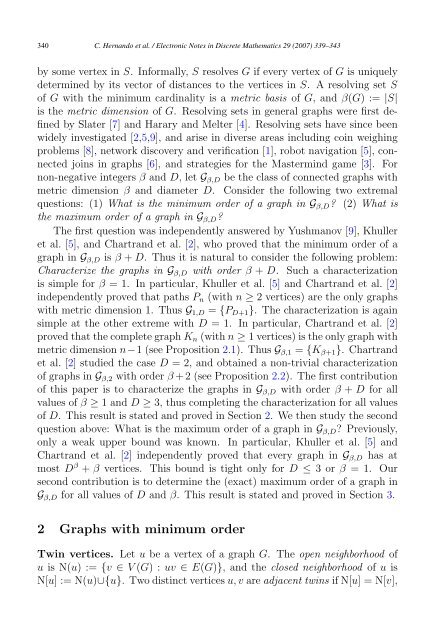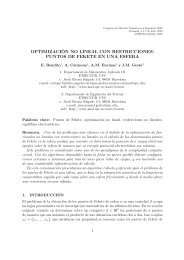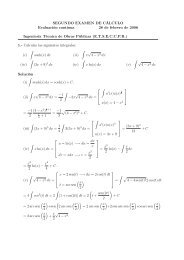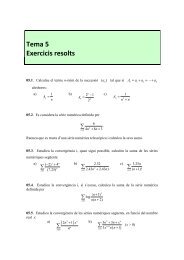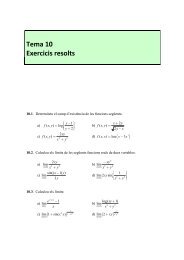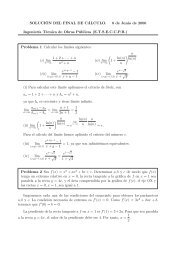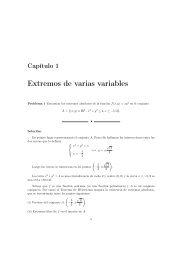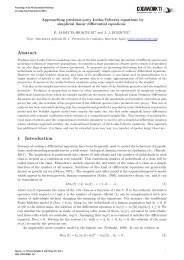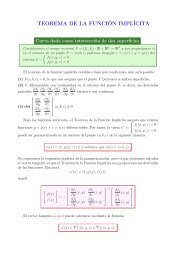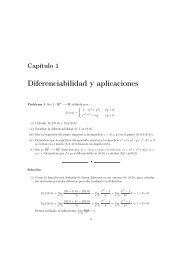Extremal Graph Theory for Metric Dimension and Diameter
Extremal Graph Theory for Metric Dimension and Diameter
Extremal Graph Theory for Metric Dimension and Diameter
You also want an ePaper? Increase the reach of your titles
YUMPU automatically turns print PDFs into web optimized ePapers that Google loves.
340<br />
C. Hern<strong>and</strong>o et al. / Electronic Notes in Discrete Mathematics 29 (2007) 339–343<br />
by some vertex in S. In<strong>for</strong>mally, S resolves G if every vertex of G is uniquely<br />
determined by its vector of distances to the vertices in S. A resolving set S<br />
of G with the minimum cardinality is a metric basis of G, <strong>and</strong> β(G) :=|S|<br />
is the metric dimension of G. Resolving sets in general graphs were first defined<br />
by Slater [7] <strong>and</strong> Harary <strong>and</strong> Melter [4]. Resolving sets have since been<br />
widely investigated [2,5,9], <strong>and</strong> arise in diverse areas including coin weighing<br />
problems [8], network discovery <strong>and</strong> verification [1], robot navigation [5], connected<br />
joins in graphs [6], <strong>and</strong> strategies <strong>for</strong> the Mastermind game [3]. For<br />
non-negative integers β <strong>and</strong> D, let G β,D be the class of connected graphs with<br />
metric dimension β <strong>and</strong> diameter D. Consider the following two extremal<br />
questions: (1) What is the minimum order of a graph in G β,D ? (2) What is<br />
the maximum order of a graph in G β,D ?<br />
The first question was independently answered by Yushmanov [9], Khuller<br />
et al. [5], <strong>and</strong> Chartr<strong>and</strong> et al. [2], who proved that the minimum order of a<br />
graph in G β,D is β + D. Thus it is natural to consider the following problem:<br />
Characterize the graphs in G β,D with order β + D. Such a characterization<br />
is simple <strong>for</strong> β = 1. In particular, Khuller et al. [5] <strong>and</strong> Chartr<strong>and</strong> et al. [2]<br />
independently proved that paths P n (with n ≥ 2 vertices) are the only graphs<br />
with metric dimension 1. Thus G 1,D = {P D+1 }. The characterization is again<br />
simple at the other extreme with D = 1. In particular, Chartr<strong>and</strong> et al. [2]<br />
proved that the complete graph K n (with n ≥ 1 vertices) is the only graph with<br />
metric dimension n−1 (see Proposition 2.1). Thus G β,1 = {K β+1 }. Chartr<strong>and</strong><br />
et al. [2] studied the case D = 2, <strong>and</strong> obtained a non-trivial characterization<br />
of graphs in G β,2 with order β + 2 (see Proposition 2.2). The first contribution<br />
of this paper is to characterize the graphs in G β,D with order β + D <strong>for</strong> all<br />
values of β ≥ 1 <strong>and</strong> D ≥ 3, thus completing the characterization <strong>for</strong> all values<br />
of D. This result is stated <strong>and</strong> proved in Section 2. We then study the second<br />
question above: What is the maximum order of a graph in G β,D ? Previously,<br />
only a weak upper bound was known. In particular, Khuller et al. [5] <strong>and</strong><br />
Chartr<strong>and</strong> et al. [2] independently proved that every graph in G β,D has at<br />
most D β + β vertices. This bound is tight only <strong>for</strong> D ≤ 3orβ = 1. Our<br />
second contribution is to determine the (exact) maximum order of a graph in<br />
G β,D <strong>for</strong> all values of D <strong>and</strong> β. This result is stated <strong>and</strong> proved in Section 3.<br />
2 <strong>Graph</strong>s with minimum order<br />
Twin vertices. Let u be a vertex of a graph G. The open neighborhood of<br />
u is N(u) :={v ∈ V (G) :uv ∈ E(G)}, <strong>and</strong> the closed neighborhood of u is<br />
N[u] :=N(u)∪{u}. Two distinct vertices u, v are adjacent twins if N[u] =N[v],


